Karnivool guitarists discuss Asymmetry album
An in-depth guitar interview
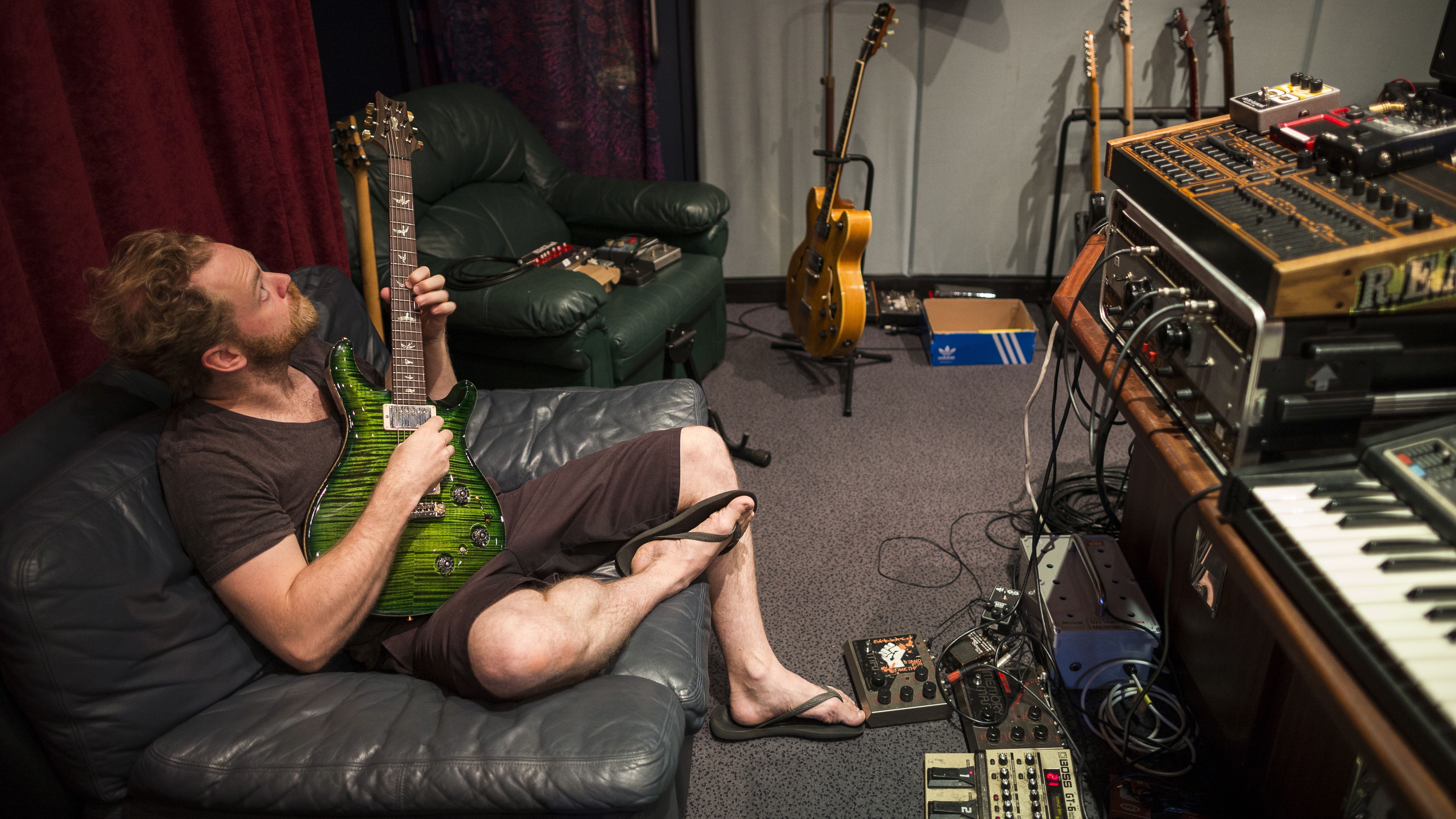
From a 'Bag Of Dicks' to being a drummer at heart; the art of progression is a strange journey for some guitarists. Especially if you're in Total Guitar's favourite Australian musical combo Karnivool.
We met up with guitarists Drew Goddard and Mark Hosking for an in-depth talk about the writing, recording and gear behind the complex and ambitious beast that is their third album Asymmetry.
When you began thinking about writing this album, did you have discussions as a band about where you wanted to go next?
Drew: "There were a few discussions along the way, but generally we just tried to get into it and start writing. I think we knew we wanted to pursue the human element a lot more - to try and make it a lot more raw, a more realistic version with the listener in the room with the band. Warts 'n' all, but also holding true to the hi-fi aspect of Karnivool that we didn't want to lose. We were trying to hold on to the right balances."
In terms of guitars, was the balance between being raw and lush with the tones difficult to strike?
Drew: "It is a difficult balance to find. There are a lot of balances: the record is called Asymmetry, so we went two sides of the coin with a lot of things we do. It's almost like we're pushing in two directions a lot of the time. But as Jon [Stockman] our bass player said, 'Are we actually doing that or are we going round in a circle and finishing at the same point?' There's the dark and the light, and the raw and the produced. We try not to think about it too much."
Why did you choose Nick DiDia to produce?
Want all the hottest music and gear news, reviews, deals, features and more, direct to your inbox? Sign up here.
Drew: "Well, he moved over to Byron Bay for a start, which is a place we wanted to hang out in! [laughs]"
Mark: "It worked out that way, actually. We had him on our list and he was a big option for us. Then the natural course of how we were doing things and where the studio was were pieces falling into place. After chatting with the guy and getting to know him, we pushed it from there."
Drew: "I should add that we wanted to try something different. All the records we've done before we worked with Forrester Savell, and we just felt like we needed to try something new to challenge ourselves. What's going to happen in the future as far as producers, we have no idea. But it's something we felt we needed to do because we've grown up with Forrester and it was time leave the nest in that way."
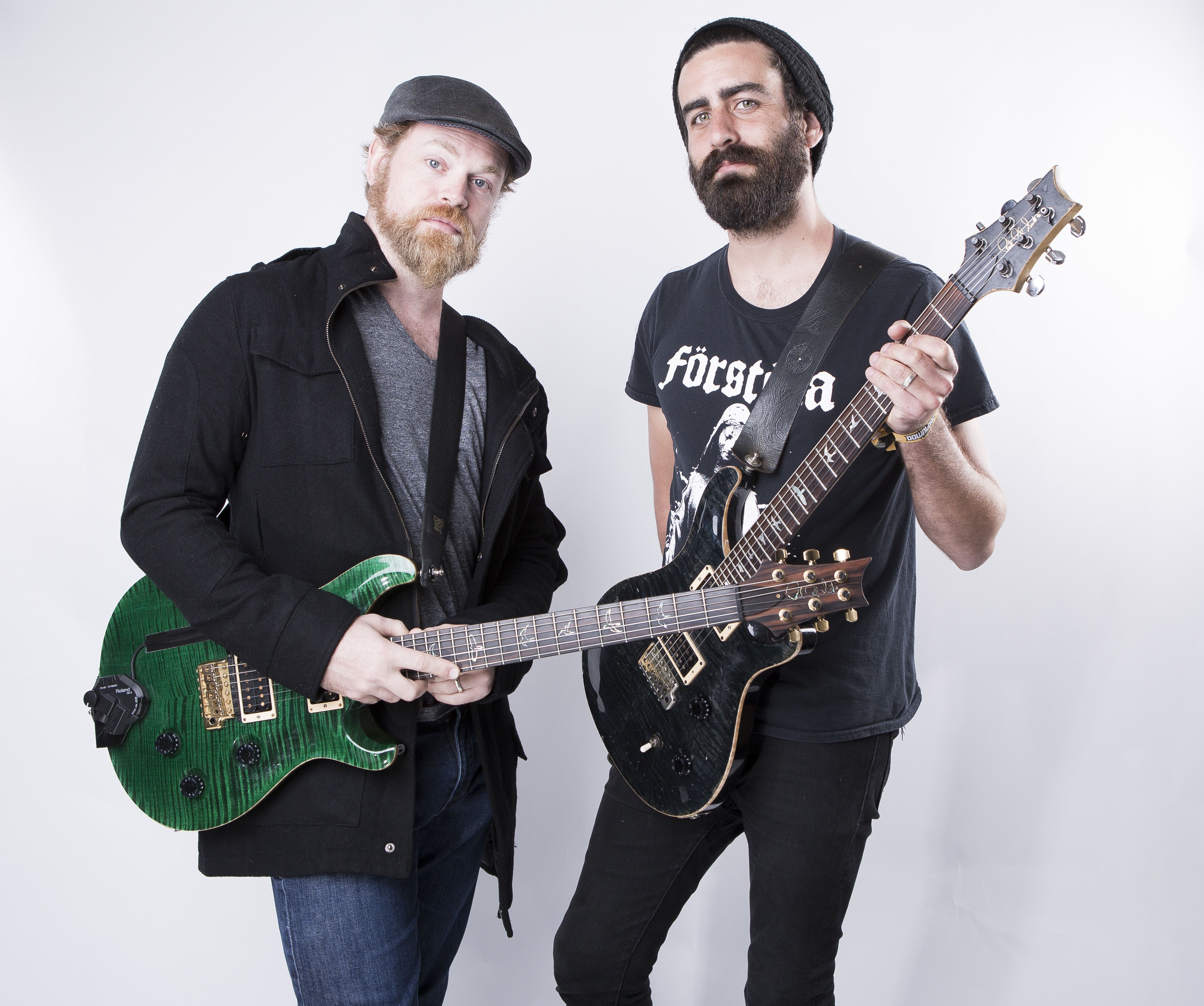
Image: © Adam Gasson
"I think we knew we wanted to pursue the human element a lot more - to try and make it a lot more raw, a more realistic version with the listener in the room with the band."
You've said that the creative process for your previous album, Sound Awake, was an arduous process. How did Asymmetry compare?
Drew: "Even more so."
Mark: "Yeah, probably more so. We went in with great expectations of streamlining processes…"
Drew: "It was a royal pain in the arse in every way possible!"
Mark: "Which again comes back to that album title and it was like that on so many levels - some of it came together [easily] and other things went off on complete tangents. It was challenging on lots of levels."
There seems to be two sides of your guitar approach: one is more guitar-driven, which we hear on The Refusal and A. M. War, and then there's this textural side on other songs where you're giving the rhythm section freer reign and focus. How consciously were you trying to develop and explore that?
Drew: "That's another one of those yin and yang sort of things. We wanted to have punch, but we're into texture and we love bands like Sigur Rós, even Jakob from New Zealand, and some of the post-rock stuff that creates these vast landscapes of sonic amazingness that we want. But we still want that punch, which I think the rhythm section really brings. A lot of the times the guitars are a textural thing, and there are certain times that the guitar needs to come to the front, but it's pretty hard when you've got a bass player whose got a sound like that. We get riff-blocked a lot!"
Did many songs begin with ideas from Jon or Steve Judd (drummer)?
Drew: "A lot."
Mark: "We Are is probably a perfect example."
Drew: "And a song like Aeons, which is very much based on the [hums starting groove] - that bass and drum groove."
Mark: "It's a groove that works that we can build on."So how do you two work together when you've got these ideas? It sounds like the interaction between you two is methodical…
Mark: "Experimenting is what it stems from."
Drew: "But as far as things being carefully placed and things being in their right spot, it's another one of those balance things. We like to jam and let things happen."
Mark: "Find a hole…"
Drew: "But naturally, because that's when things aren't planned at all. I think that's where most of our good stuff comes from, when we don't think about it but let it happen. Then we take it into the room, into the studio and work on Pro Tools. We take that idea from the jam and we try to expand on it. That's when you start placing things and see how they interact with other sounds in the mix, how they complement each other or how they don't complement each other. Sometimes you want things to grate against each other. It's a mixture of spontaneity and the more planned course of action."
How many songs come from the flow of jams between you in a room? Eidolon sounds like it has that quality at its core…
Mark: "That is from a direct jam that started off as us just jamming in a room. A fair bit of it does start from that. But then we take it back and look at sections closer, change bits - it moves on I guess."
Drew: "I'm more a fan of the jamming thing, because it's not over-thought…"
Mark: "And some of our better sections have come from that, for sure."
Drew: "Especially watching Jon and Steve, it's like they're a channel. They're not actually thinking about what's going on they're just switched off, but switched on at the same time if that makes any sense. It comes through them as opposed to overanalysing and thinking about stuff."
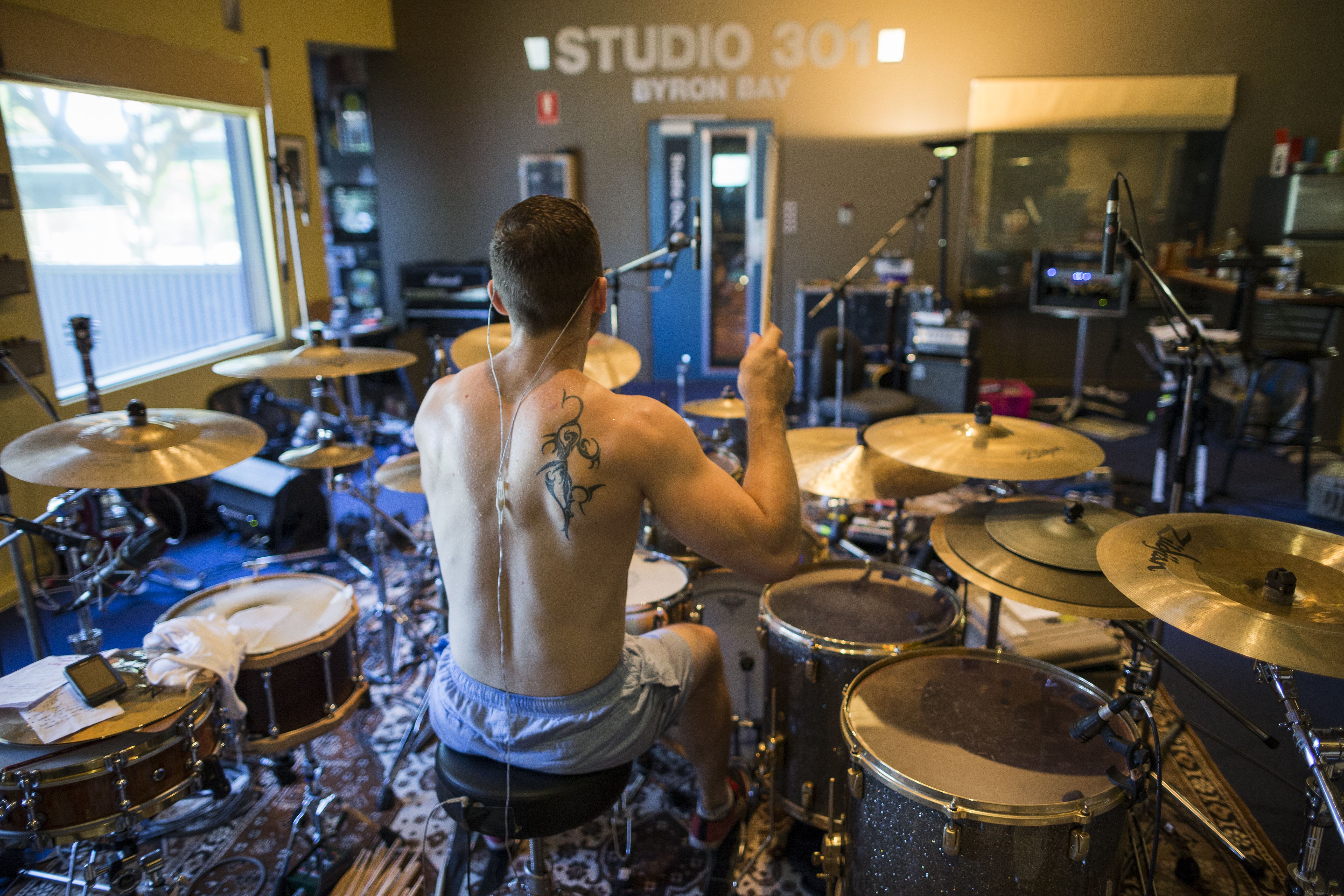
Image: © Kane Hibbard
How do you feel that you both emerged on the other side of the creative process this time?
Drew: "Jaded as f**k!" [laughs]
Mark: "I've started practising my drums! I don't know… as we've said on other albums, the guitar is a means to make a sound. I don't think either of us consider ourselves amazing guitarists…"
Drew: "Not at all."
Mark: "As guitarists maybe we've slightly improved."
Drew: "First and foremost I'm a drummer. I don't consider myself to be a guitarist in the slightest."
That's something you told us back when Sound Awake was released, so it's still the case for you?
Drew: "Yes, there are guitarists I look up to and idolise - Dimebag, Fredrik Thordendal, Kim Thayil, Brian May, Angus Young… they're real guitarists. As far as I'm concerned my strength is my imagination and my patience as far as putting these big compositions together. When it comes to guitar it's just a vehicle."
Did you work quite closely again with Steve on the drum side of things, Drew?
Drew: "Yes, but not as closely as Jon, our bass player, works with him. They're very much a unit, those two. When they get together they are inseparable."
Mark: "We call them Paris and Nicky!"
Drew: "As far as the drumming thing goes, I'll usually leave it up to Steve. I'll have a lot of input as far as the rhythmic direction of a song might go, but I can dictate that from the guitar. Steve is another league and is very imaginative as a drummer."
Mark: "We have a lot of confidence in Steve. The way he drums and works in this band is amazing."
Nachash, A.M War and The Refusal are in the first half of the album - they're quite abrasive and menacing. Is their placement making a statement?
Drew: "There's a little bit of that. But I think Nachash is something we wrote for Sound Awake. It didn't end up making the cut, and we were trying to get it finished but left it off. I'm glad we didn't put it on Sound Awake because the song structure and everything about it felt premature. But there's also the other factor of the album flow - you want it to do its own thing and expand, make a statement not just at the start but it's got to make sense as a flow from start to finish. And that's where everything felt like it wanted to sit on the record."
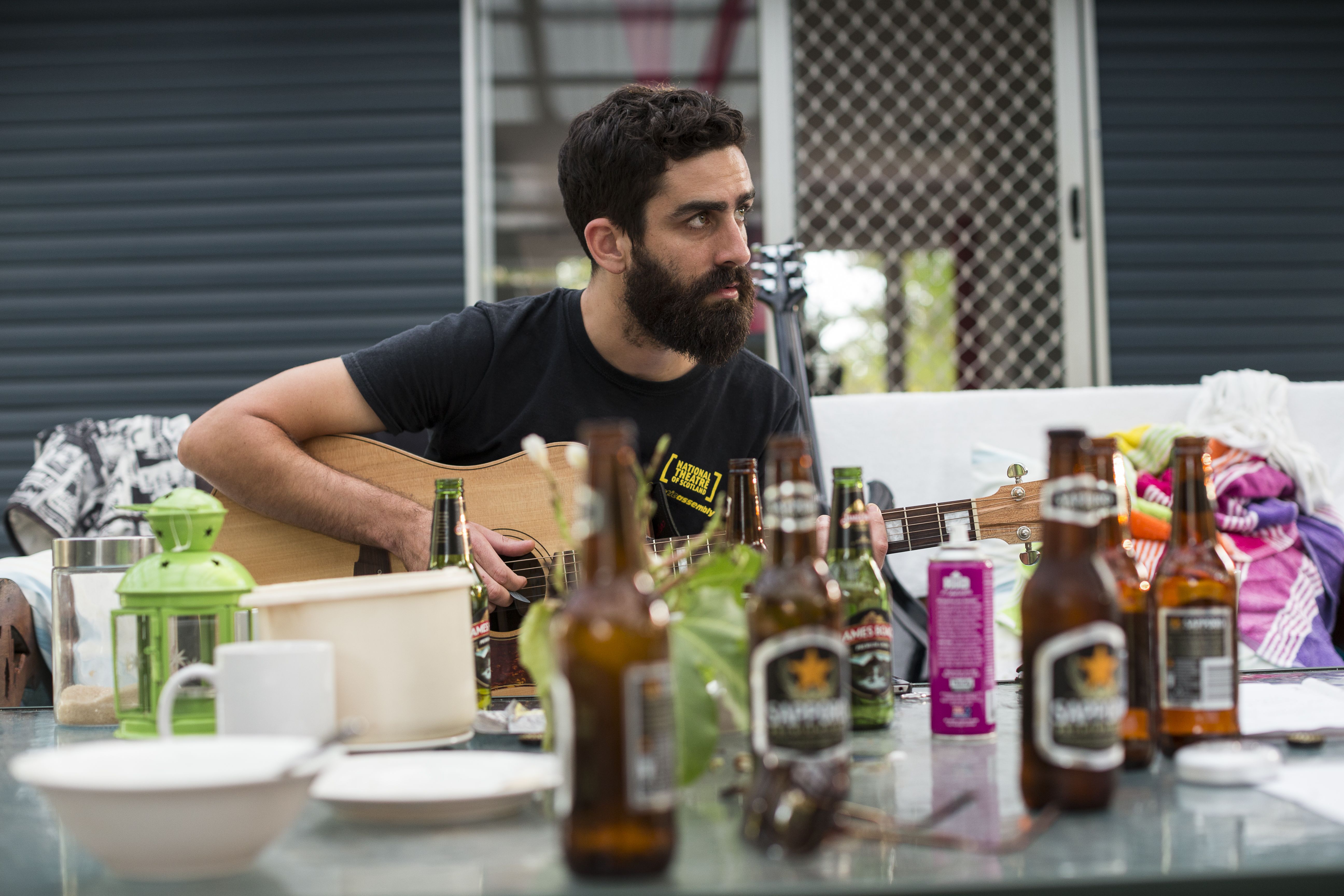
Image: © Kane Hibbard
"A whole bunch of good riffs stuck together doesn't make a good song."
Did you write these songs with evolution on the live stage in mind, that some parts may be expanded on or emphasised later?
Mark: "We always talk about that. I don't think we've nailed that yet, but it's something we definitely want to be doing - expanding songs in a live perspective."
Drew: "The finished version of the song that goes on the record is one version…"
Mark: "One of six we've probably been talking about…"
Drew: "And there are so many riffs and ideas…"
Mark: "That you want [the track] to be in there but didn't make it for various reasons, but they're still floating around in the ether…"
Drew: "It's such a hard thing to do as well because you get so attached to these sections. Aeons, for example, which is a song I'm very happy with on the record, but my favourite part of the song - well, it isn't a part of the song because it didn't make it on there. You have to sacrifice these kind of things in the name of the song. Sometimes you can think, 'Well, maybe that can creep its way back into a live version.' We can introduce these other ideas that didn't make the cut of the record."
Mark: "A song like Alpha is another where we're discussing using bits that didn't make the cut that we may be doing live. All of this is a work in progress and it's a hard thing to do because you want to represent the album track as people know it. But at the same time I love seeing bands where they go sideways sometimes. But I think you've got to be very careful with that as well."
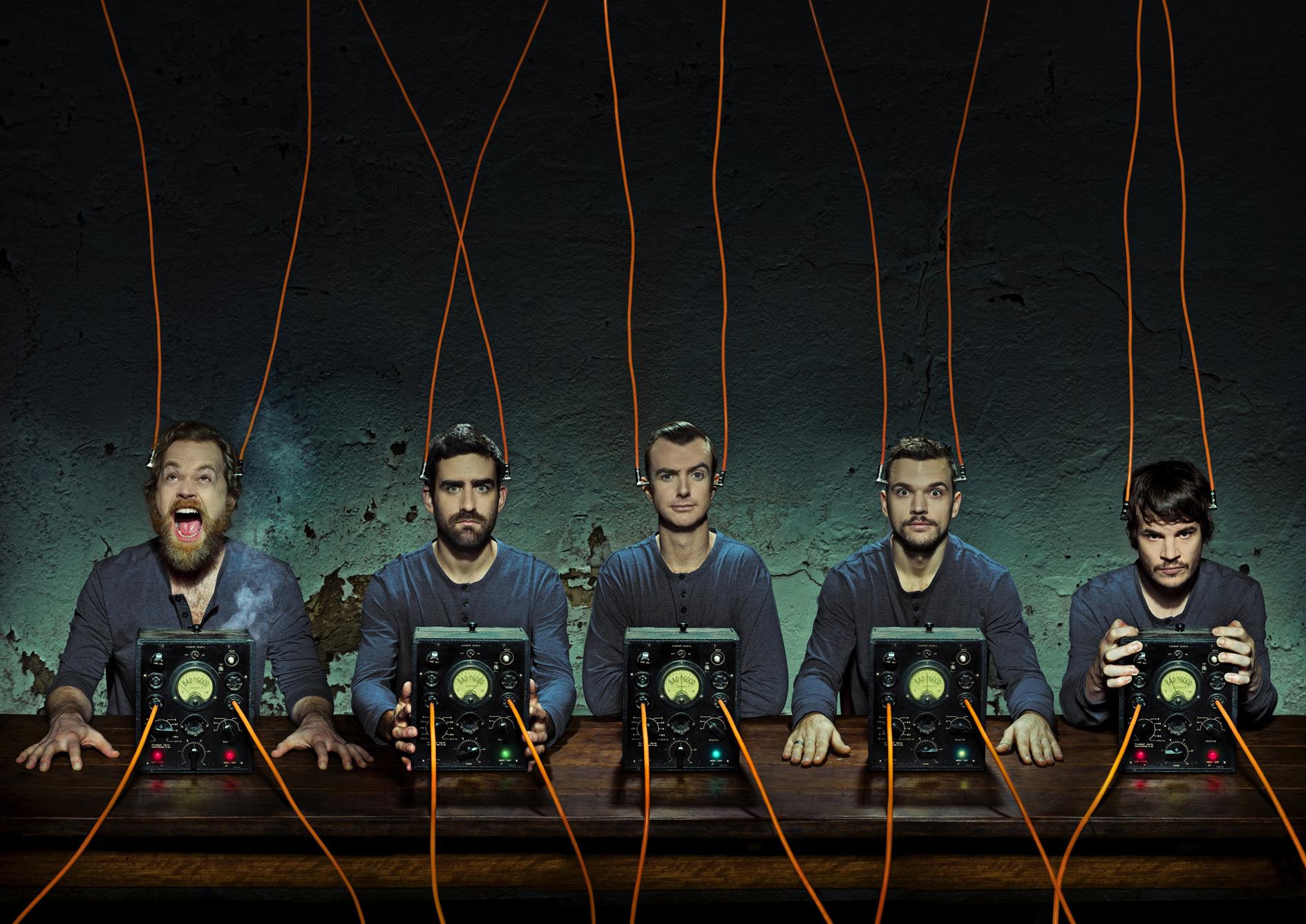
It's interesting that you've sacrificed parts of songs that you were attached to…
Both: "It's hard."
Mark: "That's where the democracy comes in."
Is that a case of taking a step back or do other member's weigh in with their own perspectives on the song?
Mark: "It changes between songs: sometimes it's obvious that there's a bit that you want to get in there, but even you can't make it fit. And other times it's just a democratic process."
Drew: "The section I was just talking about that still pains me, you put it in there and it's awesome. But then you have to zoom back and look at the songs as a whole. And if it doesn't have the same impact… the only thing that matters is the song. A whole bunch of good riffs stuck together doesn't make a good song."

Image: © Adam Gasson
A lot of bands don't like playing new material live because it ends up on YouTube, but you road-tested a number of these songs live before recording. Is that a vital part of the process for you?
Mark: "It's something we've always done. We did it on the last album and I think you do get something from playing your song live that you wouldn't otherwise get that perspective from. I don't think the songs changed too much from live to what we ended up recording. Sections might have disappeared in a couple of them."
Drew: "There are so many things, even if it's just little inflections on the riff, so many different variations, that we sometimes get a little too caught up in that sort of stuff. But it's all part of the overall picture, I think. We've got to go back through all our old jams if we want to do this sort of thing. And there are so many things that got left behind that we can use again for the live stage."
Mark: "Playing stuff when people in the audience have no idea what it is, you can always gauge a good reaction on how they're responding to sections or how they respond to the song as a whole. It's always interesting."
Moving on to gear, is it safe to say you brought a lot of effects pedals into the studio?
Mark: "Well, we lost a lot! There's still s**t we can't find."
Drew: "We love our effects. There are lots of wonderful boxes of glory that we used…"
Mark: "Begged, borrowed and stole."
Drew: "We used lots of fuzzes and interesting overdrives. Anything that colours the sound in a weird and wacky way - like the [Devi Ever] God Zilla. There's a pedal called the Uglyface, it's an 8-bit fuzz. All the kind of stuff most people would pick up and say, 'What the f**k am I going to use that for? That's disgusting!' That's the sort of pedal I want."
Mark: "Did we end up using Bag Of Dicks? Did that get a run?"
Drew: "There's a pedal called the [Gooby Electronics] Bag Of Dicks that we just added there to put things in perspective [laughs]. Lots of delays, too, of course - we tried to use a lot of tape delay this time."

There are some amazing ethereal sounds going on, like the swells in We Are. What are you using there?
Drew: "There was a vibrato, which sort of bends the pitch up and down slightly, then we added a [Boss SG-1] Slow Gear. Then there was chorus and delay."
Mark: "Cool sounds - adds that floaty 'I'm slowly losing my mind sort of sound'."
Drew: "The pitch bending in and out gives it that 'there's something not quite right' feel."
To what extent to effects and sounds inspire ideas in the writing process?
Drew: "A lot of the time sounds inspire a song. The first thing that came about for We Are was Jon's rhythm [hums rhythm] and then it slowly turned into that tremolo riff, then the drumbeat came and then that guitar part came and then Kenny's vocals. The guitar came last actually."
What's the core gear for the heavier songs?
Drew: "Lots of amps. My 5150 died, which has been my go to amp for every record. So I was like, 'Maybe it's a sign!'"
Mark: "Which is weird because normally it's the core of the Karnivool guitars."
So that didn't show up on the album at all?
Drew: "Not really. I thought it was a chance to experiment with some stuff. I was really keen on that Matamp the MKII, which we hired. There's a fellow called Matt Pike [High On Fire] who uses one of those and I love his guitar sound, so I though it was about time I tried that. Then there was the Bad Cat Hot Cat 30, which our bass player owns."
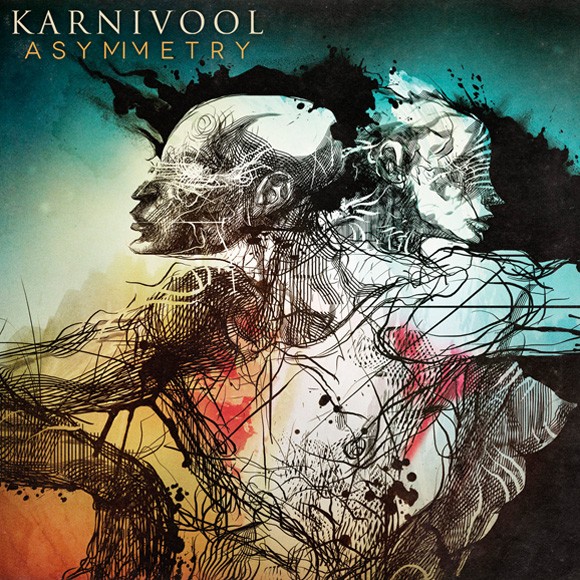
You used that on Sound Awake as well, didn't you?
Drew: "Yes, we did, but not as much as on this record. It's a 30-watt and you just crank the s**t out of it and it sounds amazing."
How will you go about recreating the tones? Have you considered modelling like the Kemper and Axe-Fx, or are you still amp purists at heart onstage?
Drew: "We used Axe-Fx quite a lot on the album but for effects."
Mark: "Not for the in-built [amp] replicators. We haven't really got our heads around that…"
Drew: "I need the air of an amp blasting past my kneecaps. The Axe-Fx thing to me is amazing and we love the delays and what you can do to filter some of those sounds as they're going on; it's like nothing you can do with any other unit. It's so intuitive if you know what you're doing on it. So I had to spend a little time to find out what was going on. But as far as the amps sounds go, the only band to me that pull [modelling] off with flying colours is Meshuggah. They didn't even use an Axe-Fx on their last record - it was a Cubase plug-in."
Did you use many plug-in effects?
Mark: "When we demo, we kind of produce as we write, so at our studio in Perth we soundscape and create stuff using our Pro Tools rig there that we have a nice selection of plug-ins for."
Drew: "We're fans of the SoundToys stuff - there's some great otherworldly sounds you can get with the Crystallizer and the Echo Boy. The H Delay has some great stuff on it."
Mark: "All the soft synths and the Omnispheres."
You're not afraid to integrate this technology live. Not a lot of players would consider integrating plug-ins live…
Drew: "That's Mark's kettle of fish really…"
Mark: "Yeah, it's nice and using it live is interesting because you don't want to overdo it. And when you're talking about listening to an album like we normally do, we sit down and think, 'Now there's the album, how the f**k are we going to go about playing this live?!' You don't want it to sound like a billion tracks being played, you want to be a live band being supported by some cool stuff in the background. It's a pretty fine line to walk sometimes."
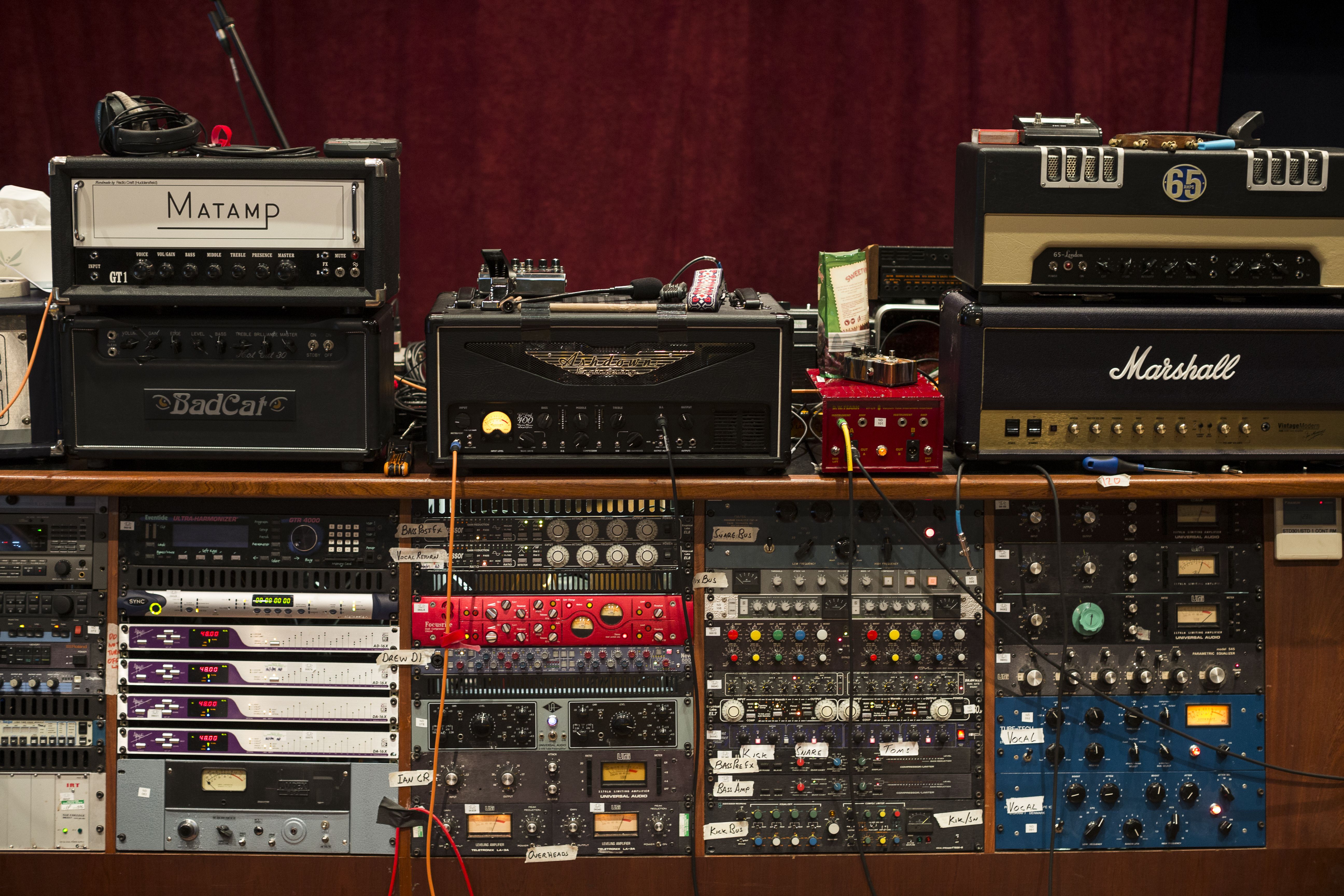
Image: © Kane Hibbard
With the samples you use, are they something you like to activate in real-time live?
Mark: "We do that. We have an old Behringer 1010 that's somehow still surviving believe it or not. It rattles when you shake it, so I don't know what's wrong with it. Some of the older stuff, and with some of the new stuff we launch various bits and pieces. A lot of it is still on backing tracks but we love the idea of getting away from that."
What's the weirdest setup you've used to create a sound?
Mark: "We've done some weird things, man. One of the weirdest thing we ever did is when we used to do Synops live. We used to run it through a Pro Tools rig and Steve only had eight pads to play the electronic section. So what I'd so is I'd press bank one, put the volume down and when he got to the end of the first section I'd go to bank two and turn the volume back up. He'd play the second section with the pads and we had four sections like that. So while he's hitting his pads I'd be changing the banks of his different samples through the song. That was quite labour-intensive, so we f**ked that off pretty quickly!"
Drew: "For Goliath, we got a children's choir in to sing. And remember that time on Themata? It didn't actually end up making the record because it was such a ridiculous idea. The place where we recorded Themata, we had this grand idea, it's almost like what we ended up doing with Asymmetry to have this kind of parenthesis - a start and then an end. The yin and the yang at either end of the record."
"I set up my amp on the balcony of this amazing place where we recorded a lot of the guitars for the record. It went over this valley, this expanse. The idea was that I'd stand out on the balcony and play this kind of mellow thing - it was this ascending little chordal piece. We'd have Ian [Kenny, vocals] and Forrester on one side with an [Avid] Mbox and a laptop to get the left side, walking up this gravel road. Then Mark and Jon on the other other with a laptop and an Mbox getting the right hand side."
Mark: "One of those thing that sounds great in theory…"
Drew: "Which happens a lot, and it failed miserably because all you could hear was the crunch, crunch, crunch!"
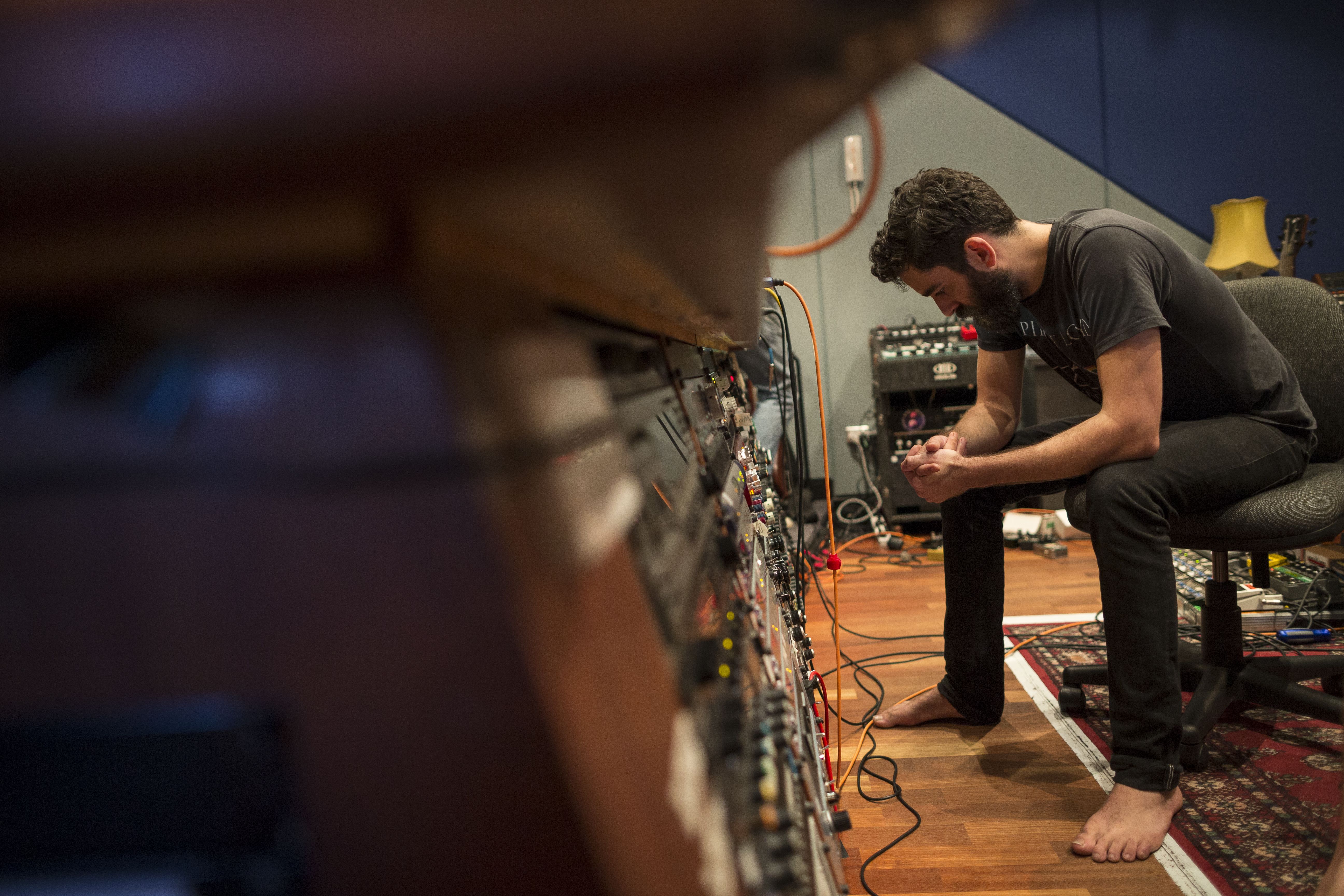
Image: © Kane Hibbard
What tones are you proudest of on this album?
Drew: "I really like the title track Asymmetry, actually. I don't know if people call it a 'song' in the band but I call it a song. It's the track that's right in the middle of the album. It was a last-minute addition that we were thinking would work with Alpha And Omega, which is towards the end of the record. I really liked the guitar sound I pulled out on that and it's an interesting guitar loop that comes on and it's almost like Battles. And I've been listening to a bit of Sun O))); that kind of overwhelming low-end guitar that is not so much an aural thing, it becomes physical to try and get that low end that shakes your whole body, which I'm still working on producing live. I used an old MXR 70s pedal with a couple of other things on that to saturate the s**t out of it with gain. I'm into that."
Did you use any of Nick's gear?
Mark: "We used a lot of his heads and a few of his effects."
Drew: "There was that Silvertone guitar that he restrung, such a simple idea but genius, actually. You take the other strings from a 12-string, then you just play what you'd normally play. It's an octave above, except the B and E, the first and second strings."
What did you use it on?
Drew: "A few songs. There was a song called Listen that didn't end up making the album, which I'm pretty gutted about because that was one of my favourite songs. But it will hopefully get an airing somewhere."
Mark: "It will be somewhere."
Drew: "We used a bunch of hollowbody Gibsons - Nick had all his guitars there. There was a Rickenbacker that I used. I can't even remember, it was a case of, 'Yeah, that'll do - bang bang, go!'"
You started expanding further on the tuning side of things on Sound Awake. What about this time?
Mark: "There are a few more tunings in there."
Drew: "Lots of silly tunings. Lots of really dissonant tunings where it goes up in either tritons or flat 6ths, so you have to do some weird shapes in order to get a normal kind of chord."
Mark: "We're trying to make our guitar tech insane, one chord at a time. And sometimes we play in different tunings from each other."
Drew: "That was another thing about this record. With Themata, if I played on one guitar it was doubled on the other side. It doesn't happen once on this record - one guitar is doing something one side while another guitar is doing something completely different on the other. It's the Asymmetry kind of thing I guess. It's all a little bit skew-wiff!"
Karnivool will tour the UK this week for the following dates:
13 November - Wedgewood Rooms - Portsmouth
14 - Anson Rooms - Bristol
15 - Rock City - Nottingham
16 - Garage - Glasgow
18 - Corporation - Sheffield
19 - Academy 2 - Manchester
20 - Institute Library - Birmingham
21 - Koko - London
Visit the official Karnivool website

Rob is the Reviews Editor for GuitarWorld.com and MusicRadar guitars, so spends most of his waking hours (and beyond) thinking about and trying the latest gear while making sure our reviews team is giving you thorough and honest tests of it. He's worked for guitar mags and sites as a writer and editor for nearly 20 years but still winces at the thought of restringing anything with a Floyd Rose.

